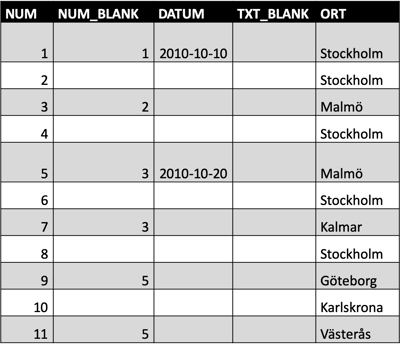Formelspråket som används i Power BI heter DAX. Språket utgörs av ett stort antal funktioner med konstanter och operatorer vilka används i formler och uttryck för att beräkna ett eller flera värden. DAX skapar helt enkelt ny information utifrån data som redan finns i din datamodell.
Funktionerna i DAX delar vi in i följande grupper: DATETIME, FILTER, INFO, LOGICAL, MATHTRIG, PARENTCHILD, STATISTICAL, TEXT, TIMEINTELLIGENCE samt OTHER.
DAX Function: DISTINCTCOUNT
Reference group: STATISTICAL
Behöver du veta hur många unika värden som förekommer i din data? Med DISTINCTCOUNT-funktionen kan du räkna antalet unika värden i en specifik kolumn i din data, till exempel på hur många olika orter har du återförsäljare.
DISTINCTCOUNT function (DAX)
DISTINCTCOUNT-funktionen räknar antalet unika värden i en kolumn oavsett vilken typ av data kolumnen innehåller. Funktionen räknar även tomma celler som ett unikt värde.
DISTINCTCOUNT generar inte en ny kolumn utan returnerar ett beräknat värde, ett så kallat Measure. Measures lagras inte i datamodellen utan beräknas vid varje tillfälle de anropas. Beroende på hur ett Measure används genereras olika resultat. Exempel på andra användningar av Measures kommer vi ta upp i andra bloggar.
Syntax: DISTINCTCOUNT(<column>)
I exemplen använder vi en tabell som heter DATA med 5 kolumner enligt nedan:
Exempel 1.
I exemplet räknar vi antalet unika värden i kolumnen NUM. Measure ”Distinct_NUM” används och innehåller resultatet. Kolumnen är numerisk och inga celler är tomma.
Distinct_NUM = 11
För att beräkna unika antalet värden använder vi följande syntax:
Distinct_NUM = DISTINCTCOUNT(’DATA’[NUM])
Exempel 2.
I exemplet räknar vi antalet unika värden i kolumnen NUM_BLANK. Measure ”Distinct_NUM_BLANK” används och innehåller resultatet. Kolumnen är numerisk och det förekommer tomma celler.
Distinct_NUM_BLANK = 5
För att beräkna unika antalet värden använder vi följande syntax:
Distinct_NUM_BLANK = DISTINCTCOUNT(’DATA’[NUM_BLANK])
Exempel 3.
I exemplet räknar vi antalet unika värden i kolumnen DATUM. Measure ”Distinct_DATUM” används och innehåller resultatet. Kolumnen är en datumkolumn och det förekommer tomma celler.
Distinct_DATUM = 3
För att beräkna unika antalet värden använder vi följande syntax:
Distinct_DATUM = DISTINCTCOUNT(’DATA’[DATUM])
Exempel 4.
I exemplet räknar vi antalet unika värden i kolumnen TXT_BLANK. Measure ”Distinct_TXT_BLANK” används och innehåller resultatet. Kolumnen är en textkolumn men innehåller bara tomma celler.
Distinct_TXT_BLANK = 1
För att beräkna unika antalet värden använder vi följande syntax:
Distinct_TXT_BLANK = DISTINCTCOUNT(’DATA’[TXT_BLANK])
Exempel 5.
I exemplet räknar vi antalet unika värden i kolumnen ORT. Measure ”Distinct_ORT” används och innehåller resultatet. Kolumnen är en textkolumn och inga celler är tomma.
Distinct_ORT = 6
För att beräkna unika antalet värden använder vi följande syntax:
Distinct_ORT = DISTINCTCOUNT(’DATA’[ORT])
Flera STATISTICAL funktioner (DAX)
Ovan har du fått exempel på hur du kan räknar antal unika värden i kolumner med DISTINCTCOUNT-funktionen. Det finns ytterligare 68 STATISTICAL-funktioner i Power BI.
Vill du veta mer vilka STATISTICAL-funktioner som finns i Power BI? Ladda då ner vår Power BI applikation som visar alla STATISTICAL-funktioner.
För att kunna använda Power BI applikationer behöver du ha Power BI Desktop installerad på din dator. Power BI Desktop är gratis och kan laddas ner här, https://powerbi.microsoft.com/sv-se/desktop/.
Vi kan naturligtvis hjälpa till med installation och att komma igång med PBI.
Håll utkik efter ytterligare blogginlägg.

